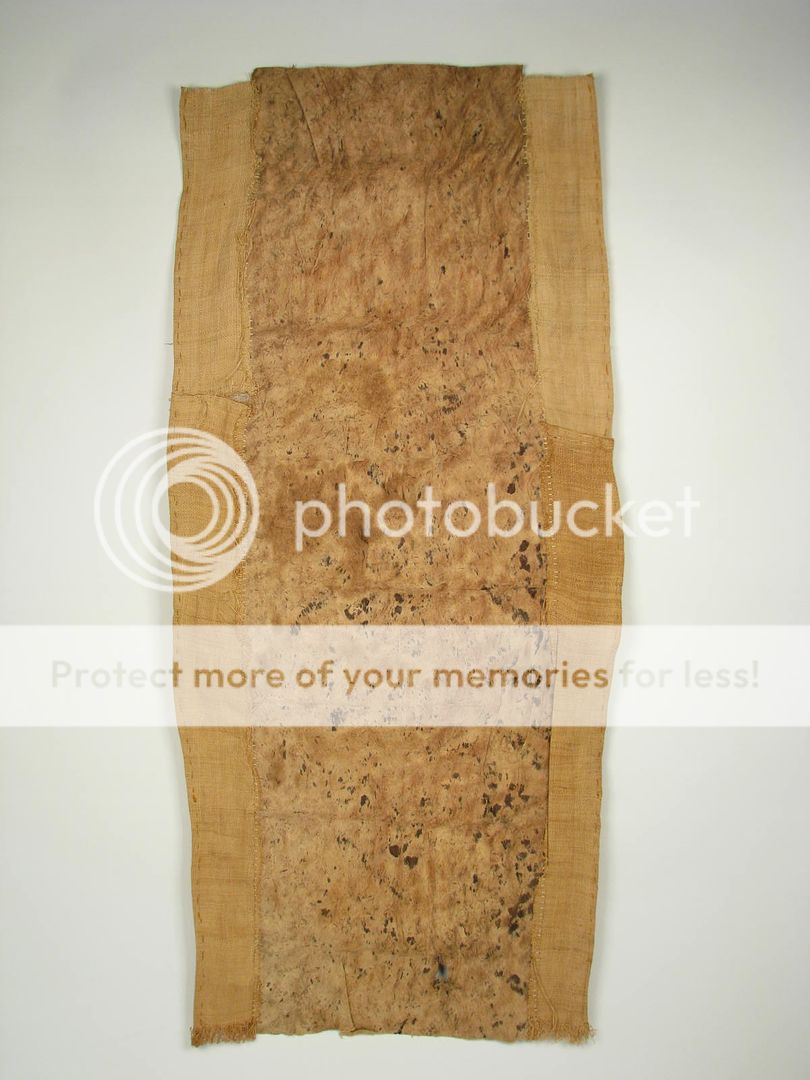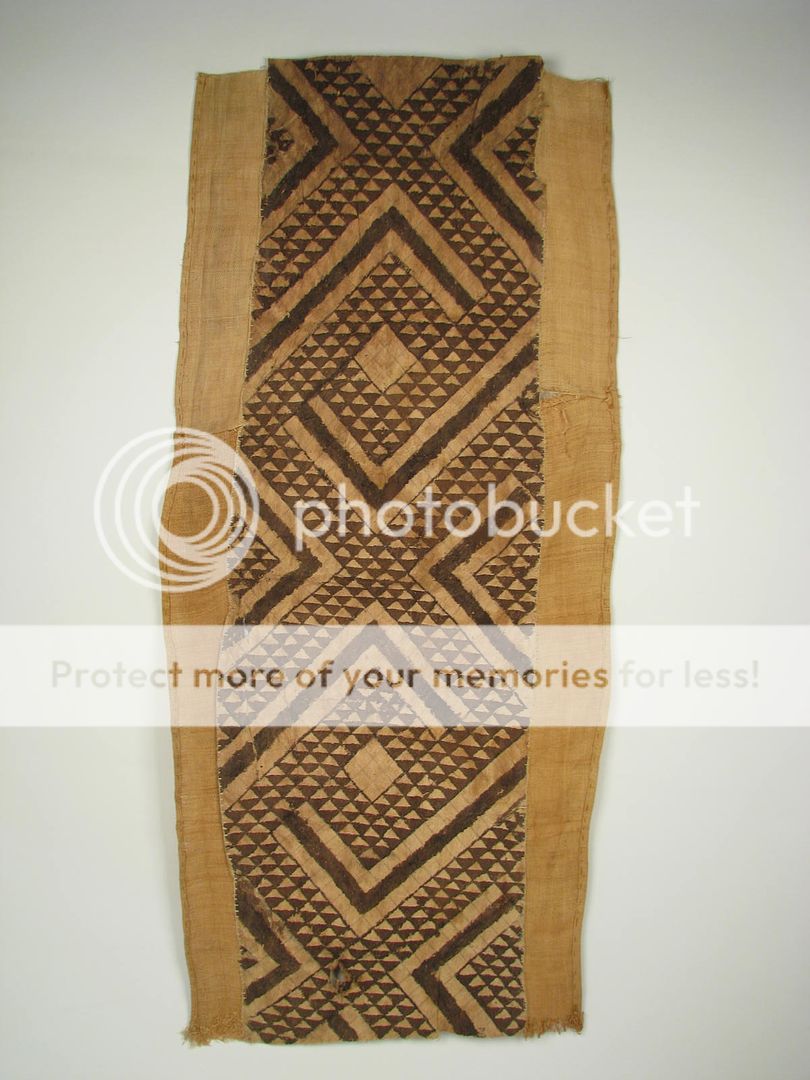| Welcome To The Premier Place For Serious Collectors of Fine Authentic African Tribal Art Over 10 Years Online Serving Thousands of Satisfied Customers
Offering the Finest Quality Sub-Saharan African Art Rare African DRC / Zaire Kuba Bark Cloth Textile Inches: Height: 38 Inches INTERNATIONAL BIDDERS WELCOME
    
Documentation of Authenticity / Any Available Provenance Will Be Included With This Piece CONDITIONSurface deterioration, worn areas, overall condition fair to good. Thank you and please view my other items. BACKGROUND The Kuba live in the area of central DRC bordered by the Sankuru, Kasai, and Lulua rivers. This is a region of valleys where numerous rivers flow south to north; the hills are covered with brush and the rivers are bordered by forests. Farming, aside from clearing the fields, was women’s work; they cultivate manioc, corn, gourds, bananas, pineapples, and palms. Tobacco was grown by the men. The hunt, a collective enterprise using nets, brought prestige and reinforced the social cohesion between the villagers. To fish the rivers required the participation of the entire village in order to build canoes. Although today most Kuba ethnic groups are organized into independent chiefdoms, they still recognize the authority of the Bushong king. The art of the Kuba is one of the most highly developed of all African traditions, and significant cultural accomplishments are part of their heritage. Among the best known of Kuba art forms are royal portrait figures, ndop, idealized representations. An ndop may have played a role in the installation of the king, and during his life it is said to have been not only a portrait but also the soul double of the king. Whatever happened to him was believed to happen to it as well. Closely associated with the king’s fertility, the ndop was kept in the woman’s quarters, and was placed next to his wives during childbirth to ensure safe delivery. The kings typically sit facing forward with legs crossed, the left in front of the right; the right hand, with fingers extended, rests on the right knee, and the left hand holds the royal dagger. Geometric patterns cover the stomach and are continued on the back of the figure. The royal statues show the king wearing a rectangular shody hat, they are mounted on quadrangular pedestals. The sculptures include objects significant to each particular king, identifying his own personal accomplishments. Developing from the court style was a popular style, which utilized geometric forms instead of the well-modeled, full-volume forms of the court figures. Kuba fetishes, emphasizing only essential organs, are highly schematic. The popular style can also be found in the utensils and textiles produced by the Kuba. Over twenty types of masks are used among the Kuba, with meanings and functions that vary from group to group. Kuba wooden helmet masks are probably the most commonly produced items, popular with the collectors. These striking masks are wonderfully decorated with geometrical surface designs in dazzling contrasts of color, pattern, and texture. Hide, animal hair, fur, beads, cowrie shells, and feathers ornament the masks, and costumes of bark-cloth, raffia fiber fabric, and beaded elements complete the manifestation of nature spirits, intermediaries between the Supreme Being and the people. One widespread context for masking is initiation. Every several years a group of boys will be inducted into manhood through the initiation which transforms uncircumcised boys into initiated men who possess esoteric knowledge. Funerals are a second important context for masks throughout the Kuba area. Three types of masks have been associated with dances that take place within the royal compound: the first, called Moshambwooy, represents Woot, the founder of the Bushoong, the culture hero. The second, known as Nady Amwaash (Ngaady A Mwash), personifies the wife/sister of Woot, a character said to have been introduced to the pageantry to give greater importance to the role of women. The third mask is called Bwoom. As a character, Bwoom has been interpreted variously as a prince (the king’s younger brother), a commoner, a pygmy, even a subversive element at the royal court. There are many differences among regional stylistic interpretations of the Bwoom mask, but the form’s most pronounced features invariably are its bulging forehead and broad nose. The drama is often reenacted in performances at public ceremonies, initiations, and funerals even of untitled men, though they are especially important at the funerals of titleholders. Bwoom is perhaps the oldest of the Kuba royal masquerade triumvirate. Oral traditions suggest that the genre may date back to about the middle of the eighteenth century. Other masks are collectively known as Isheene Mwalu. The Kuba love of form, knowledge of materials, skill in execution, and appreciation of quality are best seen in the number and variety of cups and goblets, mostly for drinking palm wine. There are reports – not confirmed – that these cups might have been used in the poison ordeal. Among the Kuba, as among other African tribes, death was never attributed to natural causes but to malevolent spirits or to witchcraft. The person suspected of using witchcraft was required to drink poison from such a cup. If he vomited up the drink, he was declared innocent. On the other hand, his death proclaimed his guilt and constituted his punishment. The Kuba smiths worked with copper, iron, and brass, making weapons and tools to be admired as well as used. In some cases, one metal was inlaid with another. The Kuba also give expression to their great artistic sense in utensils: boxes, weapons, tobacco pipes, drums, drinking horns, bells, well-known musical instrument sanza, and textiles with ingeniously designed pattern work. The luxury articles made for the court are characterized by elaborate execution and rhythmically balanced form; for it was at court that the finest artists gathered, and here that they had an opportunity to gain prestige and renown. A good carver had the rank of a senior official. Painter Fred Uhlman words - Most of the artists I admired, Picasso, Modigliani, Deraini, to mention only a few, had collected African art and had been profoundly influenced by it. Shortly afterwards I bought the Baule Fetish and the Baule bobbin which are still two of the finest pieces in my collection. It is easy to see why I bought them and why from that moment I have never stopped collecting. The head of the bobbin or heddle - pulley which is after all only a functional object for the purpose of weaving seemed to me then and today as beautiful as a Greek goddess. The fetish moved me as deeply as the bobbin by its silent tragic dignity and its air of profound meditation. GUARANTEE |
